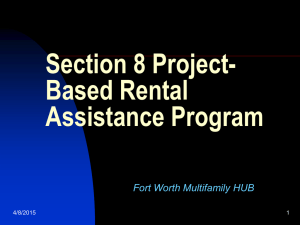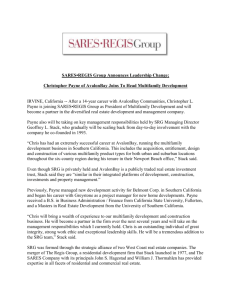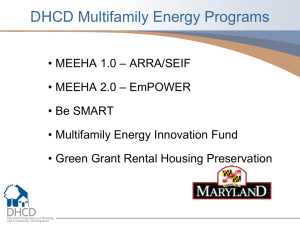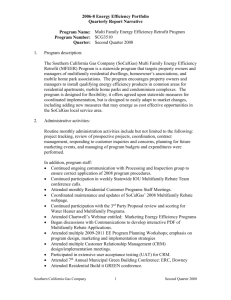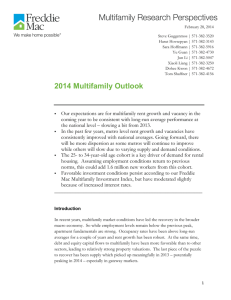Small Multifamily Properties
advertisement
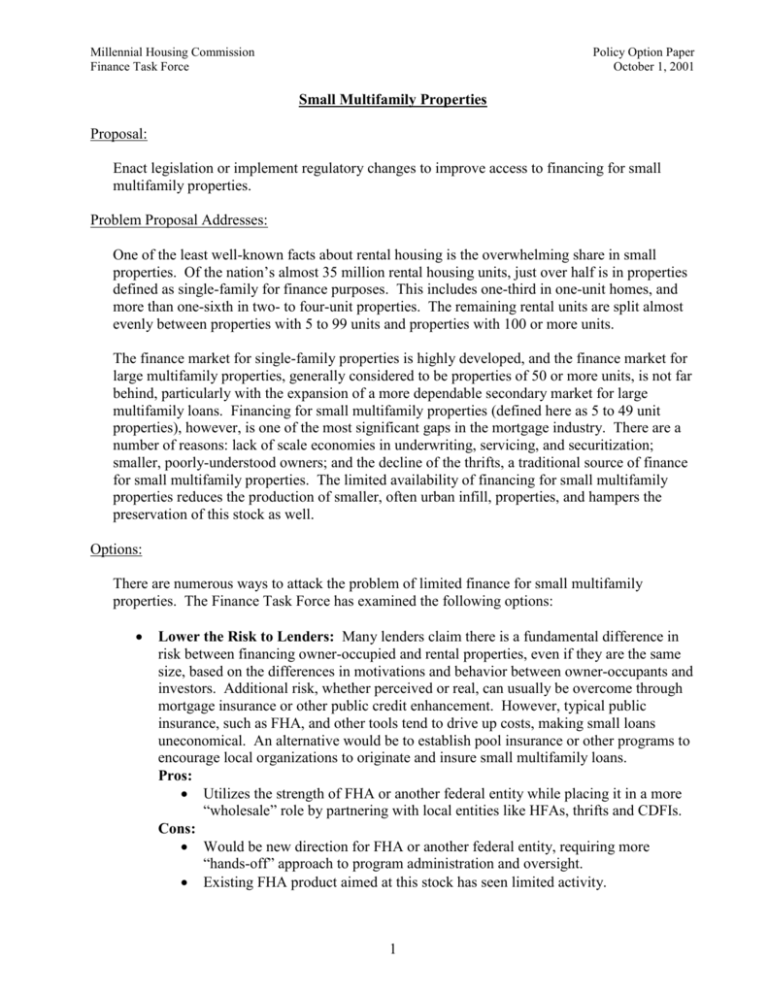
Millennial Housing Commission Finance Task Force Policy Option Paper October 1, 2001 Small Multifamily Properties Proposal: Enact legislation or implement regulatory changes to improve access to financing for small multifamily properties. Problem Proposal Addresses: One of the least well-known facts about rental housing is the overwhelming share in small properties. Of the nation’s almost 35 million rental housing units, just over half is in properties defined as single-family for finance purposes. This includes one-third in one-unit homes, and more than one-sixth in two- to four-unit properties. The remaining rental units are split almost evenly between properties with 5 to 99 units and properties with 100 or more units. The finance market for single-family properties is highly developed, and the finance market for large multifamily properties, generally considered to be properties of 50 or more units, is not far behind, particularly with the expansion of a more dependable secondary market for large multifamily loans. Financing for small multifamily properties (defined here as 5 to 49 unit properties), however, is one of the most significant gaps in the mortgage industry. There are a number of reasons: lack of scale economies in underwriting, servicing, and securitization; smaller, poorly-understood owners; and the decline of the thrifts, a traditional source of finance for small multifamily properties. The limited availability of financing for small multifamily properties reduces the production of smaller, often urban infill, properties, and hampers the preservation of this stock as well. Options: There are numerous ways to attack the problem of limited finance for small multifamily properties. The Finance Task Force has examined the following options: Lower the Risk to Lenders: Many lenders claim there is a fundamental difference in risk between financing owner-occupied and rental properties, even if they are the same size, based on the differences in motivations and behavior between owner-occupants and investors. Additional risk, whether perceived or real, can usually be overcome through mortgage insurance or other public credit enhancement. However, typical public insurance, such as FHA, and other tools tend to drive up costs, making small loans uneconomical. An alternative would be to establish pool insurance or other programs to encourage local organizations to originate and insure small multifamily loans. Pros: Utilizes the strength of FHA or another federal entity while placing it in a more “wholesale” role by partnering with local entities like HFAs, thrifts and CDFIs. Cons: Would be new direction for FHA or another federal entity, requiring more “hands-off” approach to program administration and oversight. Existing FHA product aimed at this stock has seen limited activity. 1 Millennial Housing Commission Finance Task Force Policy Option Paper October 1, 2001 Encourage Government-Sponsored and Other Lenders to Make Loans: Instead of encouraging lenders to make small multifamily loans by lowering risk, which transfers some of the cost of the loans to the public sector, lenders could instead be required to make more of these loans through the federal government’s existing regulatory powers. This has already been done, for example, through the GSEs’ affordable housing goals set by HUD. Similar requirements could be developed for the HFAs, Federal Home Loan Banks and other institutions. Pros: Does not require federal subsidies or other costs like the prior option. Cons: Will invite political opposition from regulated entities. If poorly implemented, may raise costs of housing because increased regulatory burden would be passed through to owners and ultimately residents. Lower the Cost of Underwriting, Servicing and Securitization: In addition to the perceived risk of small multifamily lending, the processes used to underwrite, service and securitize these loans are similar to those used for large multifamily loans, and therefore the cost of these processes is higher for small multifamily loans as a percent of loan size. The success of the single-family finance market, however, suggests that, despite smaller volume and different tenure, the cost of underwriting, servicing and securitization of small multifamily loans could be reduced. Federal efforts could: Improve and centralize information sources for appraisals, environmental reviews, and loan performance. Standardize documents, bankruptcy rules and title requirements across jurisdictions. Pros: Helps solve one of the fundamental barriers to small multifamily lending, thereby drawing more private capital into this market. Improves understanding of small multifamily loan performance, hopefully leading to more effective risk analysis tools and lower lending rates. Cons: Difficult to accomplish, particularly if seen as overriding local requirements. Subsidize the Cost of Underwriting, Servicing and Securitization: Despite efforts to lower the cost of processing small multifamily loans, it is likely that they will continue to be relatively more expensive than larger multifamily loans. Another alternative would be to subsidize the underwriting, servicing and/or securitization of these loans through grants to financial institutions or creation of entities dedicated to these functions. Pros: Recognizes and offsets one of the fundamental barriers to small multifamily lending, thereby drawing more private capital into this market. Cons: Higher long-term cost compared to options that lower cost of processing. 2 Millennial Housing Commission Finance Task Force Policy Option Paper October 1, 2001 Recommendations: Currently, the Finance Task Force recommends the following: Sponsor federal data collection and analysis to better understand the risks of small multifamily properties and lower the underwriting, servicing and securitization costs. Create an FHA pool insurance program or subsidize the reserves of HFAs and others that expand lending to small multifamily properties. Require HFAs, GSEs, and other regulated financial entities to increase lending for small multifamily properties, but tie the requirements to increased incentives for them. For example, increased PAB bond cap or relaxed arbitrage rules for HFAs could be made available only if an HFA increases lending for small multifamily properties. Further Background: Useful background research on the size, ownership and financing of small multifamily properties is available from the National Multi Housing Council and the Joint Center for Housing Studies (see in particular draft paper by Schnare). From 1996 to 1999, the Multifamily Housing Institute began an effort to collect and standardize operating and loan data on multifamily housing. This effort provides a starting point and useful lessons for similar efforts. The experience of the Community Preservation Corporation, certain HFAs and other lenders focused on small multifamily properties provides useful background for the creation of pool insurance or other efforts to encourage small multifamily lending. 3


